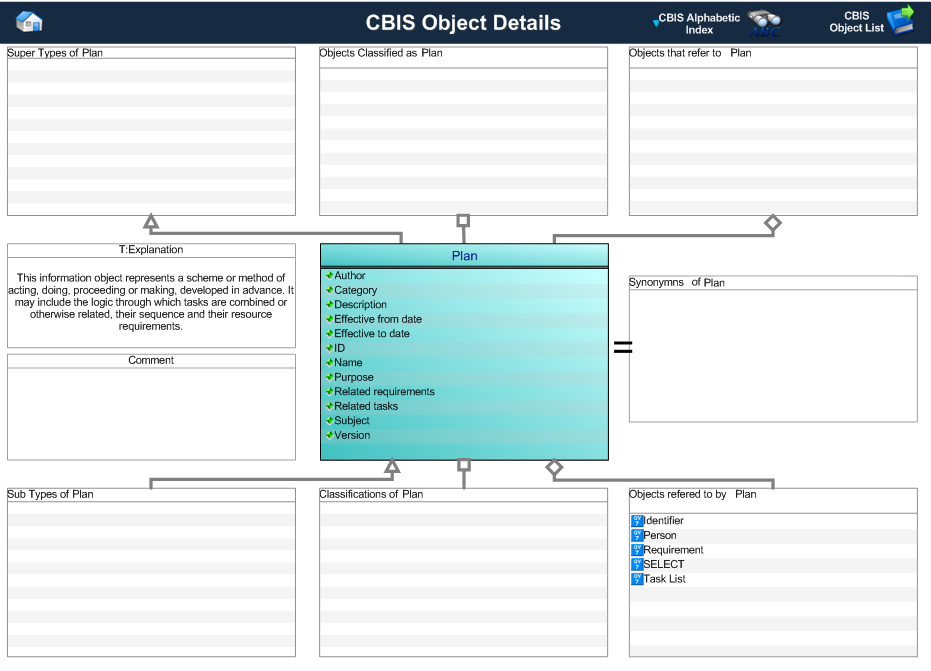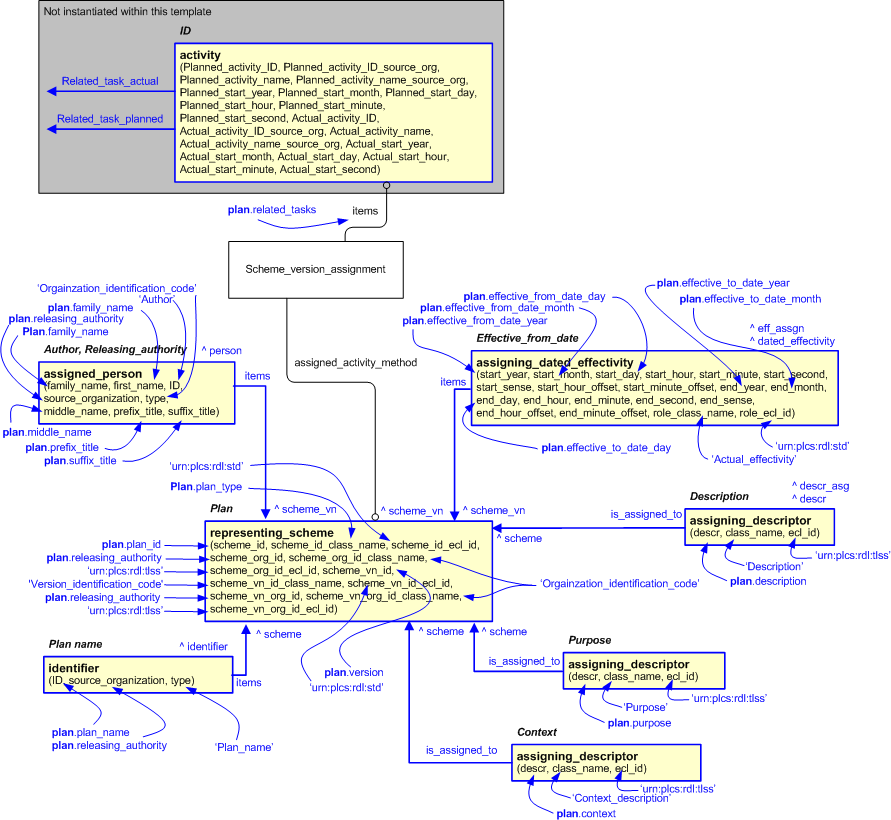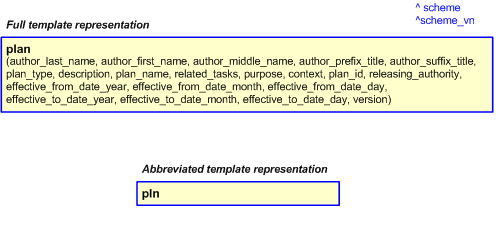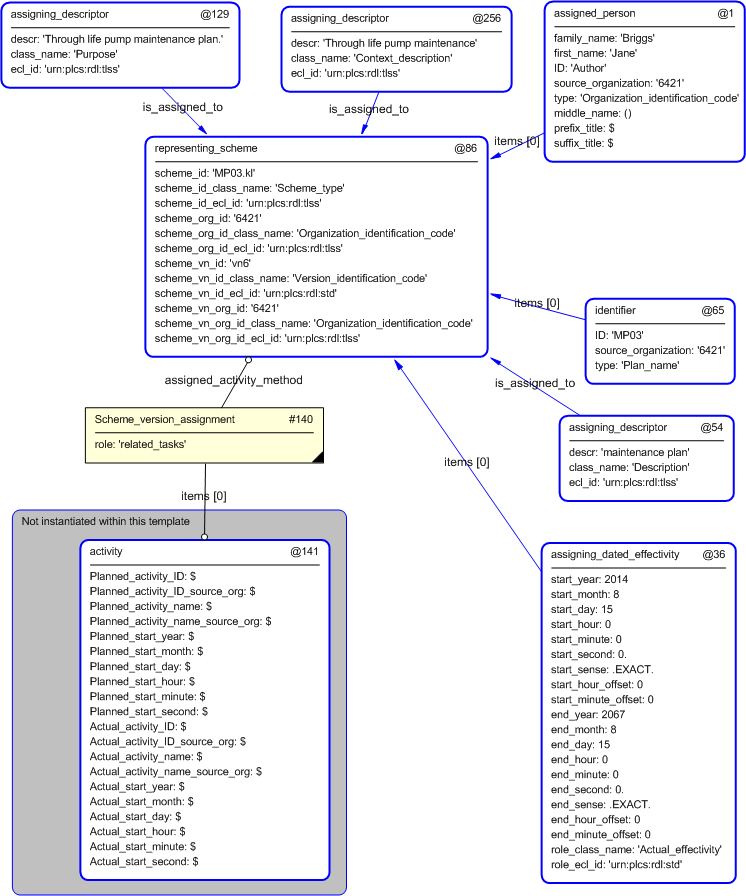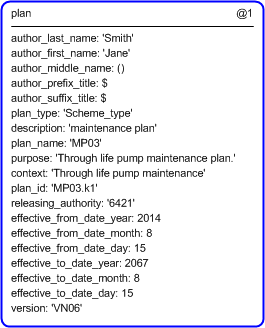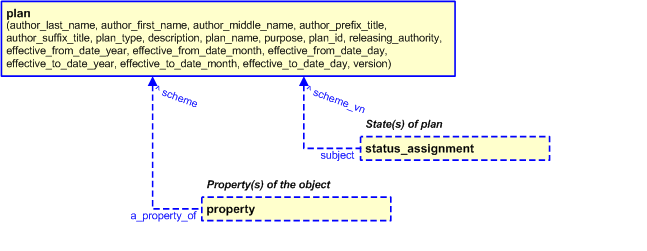Template:— plan (pln)
Context:— UK_Defence |
Date: 2009/04/17 10:48:48
Revision: 1.3
|
This section specifies the template plan.
NOTE
The template has been defined in the context of
UK_Defence.
Refer to the business context for details of related templates.
NOTE
An explanation of a template and the associated instantiation path is
provided in the
Template overview
section.
This template describes how to represent the UK_Defence concept of a Plan in terms of PLCS
model elements (templates, entities, and reference data).
This information object represents the reference material that support the preparation for a plan of events.
A plan is defined to be a set of tasks that need to be performed in a defined sequence, at defined intervals using defined
resources. Plans are defined for types of products. The structure of the information in all types of plans is likely to be
the same.
The definition of the Plan object is: A scheme or method of acting, doing, proceeding or making, developed in advance.
It may include the logic through which tasks are combined or otherwise related, their sequence and their resource requirements.
Figure 1 — Graphical Representation for Business Object plan
|
Attribute name
|
Attribute description
|
Attribute type
|
Optionality
|
| Author |
This is the reference to the information describing the author of the plan. |
Assigned_person |
Mandatory |
| Description |
This attribute provides the description of the plan. |
Intrinsic |
Mandatory |
| Effective from date |
This attribute provides the date from which the plan is effective. |
Intrinsic |
Optional |
| Effective to date |
This attribute provides the date to which the plan is effective. |
Intrinsic |
Optional |
| ID |
This attribute provides the identification of the plan. |
Identifier |
Mandatory |
| Identifier.id |
This is the value of the id attribute of the Identifier applied to the plan. |
intrinsic |
Mandatory |
| Identifier.type |
This attribute is the type associated with the id of the Identifier given
to the Plan. This must be one of the classes provided, it is intended that business users will add types of plan
as appropriate.
|
Scheme_type |
Mandatory |
| Identifier.source_organization |
This attribute is the value representing the source organization that
provides the id of the Identifier given to the Plan. This value is assumed to be a
type of Organization_identification_code.
|
Organization_identification_code |
Mandatory |
| Name |
This attribute provides the name of the plan. |
Intrinsic |
Optional |
| Purpose |
This attribute provides the purpose of the plan. |
Intrinsic |
Optional |
| Related Requirements |
This is the reference to the requirements that the plan satisfies. |
Relationship(related_requirements) to this Plan |
Optional |
| Related Tasks |
This is a reference to one or more other tasks that constitute the plan. |
Relationship(related_tasks) to this Plan |
Mandatory |
| Subject |
This is the subject for which the plan was developed and to which it applies. |
Relationship(related_requirements) to this Plan |
Mandatory |
| Version |
This attribute provides the version of the plan. |
Intrinsic |
Mandatory |
Table 1 — Plan attribute details
The EXPRESS-G diagram in
Figure
2
shows the templates and EXPRESS entities that are required
to represent the template
"plan".
The text highlighted in blue shows the template parameters.
Figure 2 — An EXPRESS-G representation of the Information model for plan
The graphic for the template to be used in other EXPRESS-G diagrams
is shown in Figure
3
below.
Figure 3 — The graphical representation of the plan template
The following input parameters are defined for this template:
The last name of the author of the plan. It is assumed that the author belongs to
the organization identified by the releasing authority.
The first name of the author of the plan. It is assumed that the author belongs to
the organization identified by the releasing authority.
The author of the plan. middle name(s).
The author of the plan. prefix title(s).
The author of the plan.suffix title(s).
plan_type (Default=Scheme_identification_code,Type='CLASS', Optional)
The category of the plan contents.
The following classes and their sub-classes can be used:
classifications: [Scheme_type]![[warning:]](../../../../../../images/dex/warning.gif) Error RDL4: The URI urn:plcs:rdl:uk_defence is not listed in dexlib/data/refdata/rdl_index.xml
Error RDL4: The URI urn:plcs:rdl:uk_defence is not listed in dexlib/data/refdata/rdl_index.xml
The description of the plan.
The identity of the tasks related with this plan.
The identifier of the plan (Plan_identification_code).
An Organization representing the publishing authority of the plan. This attribute represents ownership and the authority
to release the plan, even if the plan has been prepared by a different organization.
The year of the valid from, use date, of the plan.
The month of the valid from, use date, of the plan.
The day of the valid from, use date, of the plan.
The year of the valid to, use date, of the plan.
The month of the valid to, use date, of the plan.
The day of the valid to, use date, of the plan.
version (Default=Version_identification_code,Type='CLASS')
The following classes and their sub-classes can be used:
The following reference parameters are defined for this template:
Allow the
Scheme
entity instantiated in this path to be referenced when this template is used.
Note: The
Scheme
entity can be referenced in a template path by:
%^target = $plan.scheme%
where
target
is the parameter to which the
Scheme
is bound.
Allow the
Scheme_version
entity instantiated in this path to be referenced when this template is used.
Note: The
Scheme_version
entity can be referenced in a template path by:
%^target = $plan.scheme_vn%
The instantiation path shown below specifies the entities that are to be
instantiated by the template.
A description of templates and the syntax for the instantiation path is
provided in the
Templates Help/Information section.
/
representing_scheme(
scheme_id=@plan_id,
scheme_id_class_name=@plan_type,
scheme_id_ecl_id='urn:plcs:rdl:uk_defence',
scheme_org_id=@releasing_authority,
scheme_org_id_class_name='Organization_identification_code',
scheme_org_id_ecl_id='urn:plcs:rdl:uk_defence',
scheme_vn_id=@version,
scheme_vn_id_class_name='Version_identification_code',
scheme_vn_id_ecl_id='urn:plcs:rdl:std',
scheme_vn_org_id=@releasing_authority,
scheme_vn_org_id_class_name='Organization_identification_code',
scheme_vn_org_id_ecl_id='urn:plcs:rdl:uk_defence')/
-- assign ref parameters %^scheme = $representing_scheme.scheme%
%^scheme_vn = $representing_scheme.scheme_vn%
-- author, releasing authority /
assigned_person(
family_name=@author_last_name,
first_name=@author_first_name,
ID='Author',
source_organization=@releasing_authority,
type='Organization_identification_code',
middle_name=@author_middle_name,
prefix_title=@author_prefix_title,
suffix_title=@author_suffix_title,
items=^scheme_vn)/
-- description /
assigning_descriptor(
descr=@description,
class_name='Description',
ecl_id='urn:plcs:rdl:uk_defence',
is_assigned_to=^scheme)/
-- subject /
assigning_descriptor(
descr=@subject,
class_name='Subject',
ecl_id='urn:plcs:rdl:uk_defence',
is_assigned_to=^scheme)/
-- purpose /
assigning_descriptor(
descr=@purpose,
class_name='Purpose',
ecl_id='urn:plcs:rdl:uk_defence',
is_assigned_to=^scheme)/
-- context /
assigning_descriptor(
descr=@context,
class_name='Context_description',
ecl_id='urn:plcs:rdl:uk_defence',
is_assigned_to=^scheme)/
-- effective from date /
assigning_dated_effectivity(
items=^scheme_vn,
start_year=@effective_from_date_year,
start_month=@effective_from_date_month,
start_day=@effective_from_date_day,
start_hour=0,
start_minute=0,
start_second=0,
start_sense=.EXACT.,
start_hour_offset=0,
start_minute_offset=0,
end_year=@effective_to_date_year,
end_month=@effective_to_date_month,
end_day=@effective_to_date_day,
end_hour=0,
end_minute=0,
end_second=0,
end_sense=.EXACT.,
end_hour_offset=0,
end_minute_offset=0,
role_class_name='Actual_effectivity',
role_ecl_id='urn:plcs:rdl:std')/
-- plan name /
identifier(
ID=@plan_name,
source_organization=@releasing_authority,
type='Plan_name',
items=^scheme)/
-- Comprises of Scheme_version_assignmentScheme_version_assignment.assigned_activity_method ->
^scheme_vn
Scheme_version_assignment.items ->
@related_tasks
The instance diagram in Figure
4
shows an example of the EXPRESS entities and templates that are instantiated by the template:
/plan(author_last_name='Smith', author_first_name='Jane', author_middle_name='', author_prefix_title='', author_suffix_title='', plan_type='Scheme_type', description='maintenance plan', context='Through life pump maintenance', related_tasks='schedule1', plan_name='MP03', purpose='Through life pump maintenance plan.', plan_id='MP03.kl', releasing_authority='6421', effective_from_date_year='2014', effective_from_date_month='8', effective_from_date_day='15', effective_to_date_year='2067', effective_to_date_month='8', effective_to_date_day='15', version='vn6')/
(an illustration of the consolidated plan template is shown in
Figure
5 below.)
Figure 4 — Entities instantiated by plan template
The instance diagram in
Figure
5
shows the graphic symbol for the template that is to be
used in other instance diagrams. The example template is:
/plan(author_last_name='Smith', author_first_name='Jane', author_middle_name='', author_prefix_title='', author_suffix_title='', plan_type='Scheme_type', description='maintenance plan', context='Through life pump maintenance', related_tasks='schedule1', plan_name='MP03', purpose='Through life pump maintenance plan.', plan_id='MP03.kl', releasing_authority='6421', effective_from_date_year='2014', effective_from_date_month='8', effective_from_date_day='15', effective_to_date_year='2067', effective_to_date_month='8', effective_to_date_day='15', version='vn6')/
Figure 5 — Instantiation of plan template
The following section details how the
plan
template can be optionally characterized by assigning
other constructs to it. These are characterizations commonly
applied to the template. The ISO 10303-239 EXPRESS model may enable
other assignments to the entities instantiated by the template.
The EXPRESS-G diagram in Figure
6
shows the possible characterizations of the template
"plan".
Figure 6 — Characterizations for Plan
The following characterizations may apply:
Characterization Status Assignment
NOTE this characterization is optional.
An UK_Defence.plan
may have one or more status assigned to it, through the use of the following templates (or those based upon these):
UK_Defence.status_assignment.
The following template calls show how these characterizations
might be instantiated.
/status_assignment(assigned_status='Approved', assigned_status_ecl_id=''urn:plcs:rdl:std'', ID='SA001', ID_type='State_identification_code', ID_organization='Babcock Marine', subject='#1')/
Characterization Property
NOTE this characterization is optional.
A UK_Defence.plan
may have specific properties assigned to it, through the use of the following templates (or those based upon these):
UK_Defence.property. The following template calls show how these characterizations
might be instantiated.
/property(property_identifier='', property_ecl_id='', property_value='', property_unit='', unit_ecl_id='', si_unit='', disposition='', a_property_of='')/
